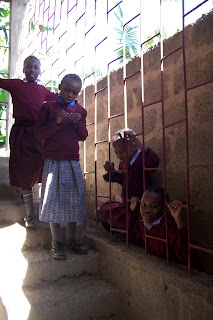Tuesday and Thursday afternoons I teach at a school called Albehije. The class I work with includes students ages 8-11. My purpose there is centered around sharing stories with a goal to generate dialog and art projects that develop both literacy, critical thinking skills and the students imaginations.
The building is still under construction. This is a shot from the stairs looking down at the ground level where most people enter the building. A week after I took this picture the chairs disappeared...
I asked students what stories they already knew and invited them to share one-by-one. They were eager and jumping with their hands raised. We went through about five stories on the first day. Each student began their sharing with “Story, story…” and awaited the group response of, “Story come!” Then, naturally, the cadence of their voice would change, they sounded authoritative and confident. At certain moments the students in the audience would coax the story on from their seats by humming, “mmhmm?” There was no air of rudeness to this behavior. In fact, it seemed to be expected in the situation.
In preparing for lessons with this group of students, I talked to teachers at Umoja who have a history of working with them. Most of my questions pertained to the level of reading comprehension and communication the students had demonstrated in the past. Then I had a very specific question. Which was, what if I asked the students to create a drawing of an animal or object they had never seen before? I wanted to know how likely it was that the students would be willing to deal with the discomfort of guessing at something, and was genuinely curious about whether or not the resulting illustrations would reveal similarities or cultural trends. The response from the teachers at Umoja was an interesting one. They warned me that I might be rushing into something that the students weren't ready for. Their concern was that a task like that would require imagination – something which there isn’t a word for in Swahili. It was argued that in the setting of Albehije, and in general, the city of Arusha, people rarely come up with things or ideas they have not experienced before. In summary, I was told that, basically, imagination doesn't exist here.
Is that true? I was doubtful, and determined that I would take small steps to find exercises that might result in a clearer understanding.
To start, I wrote a condensed version of Goldilocks and the Three Bears, and read it aloud to the class. The students created illustrations of specific scenes from the story, and then brought them together and placed them in order to form a visual story board. The students had never seen a bear before, so the illustrations are a lot of fun to look at. I eventually shared with the students, some images of brown bears in their natural environment.
In the end, we formed three groups, and took turns re-enacting the events of the story. I asked the students to use their bodies as props for each scene if their character was not performing an active role, and this is what they came up with...
Goldilocks jumps through the window - running away from home...
Mattress testing.

Chair testing.
This picture has nothing to do with the class work, I just found it funny. One of the girls depicted lost her necklace in the space between the bars and the wall. Here her friends are squeezing in to reach it.
The work the students did with Goldilocks is impressive when I think about the language barrier and the fact that many students cannot write a complete sentence in English. This group of students have had continual experience working with Umoja for the last two years. They come to Umoja on Saturdays to work with visiting artists, musicians and performers. Generally speaking, this sets them apart from many other Tanzanian students at their grade level, as it is extremely rare for Tanzanian schools to offer arts curriculum. I'm interested to see how this affects their development in the future. It is my understanding that Umoja will continue to work with this specific group of students into the next few years.
For now, the school is on break. In May we will begin a new project that will involve a video camera, lots of acting and extensive scenery and prop construction. It should be interesting…more photos to come.










No comments:
Post a Comment